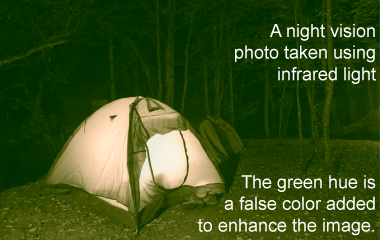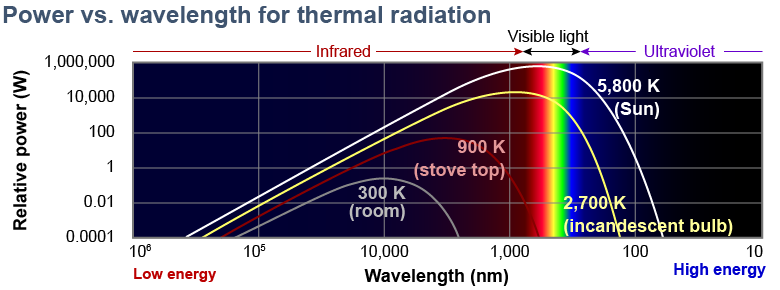|
The physics definition of radiation means the dispersal of energy through space. Both conduction and convection occur only through matter—neither can transfer energy through the vacuum of space. Radiation is different. Radiant energy can travel through space without the presence of matter. Thermal radiation consists of electromagnetic waves (including light) produced by objects because of their temperature. All objects with a temperature above absolute zero give off thermal radiation, not just the Sun. 
|
 We do not normally see thermal radiation from room-temperature objects because the energy is too low to be detected by the human eye. An infrared camera, however, sees infrared radiation very well and is the basis for “night vision” goggles. Night vision systems amplify low-energy thermal radiation to create images in higher energy visible light.
We do not normally see thermal radiation from room-temperature objects because the energy is too low to be detected by the human eye. An infrared camera, however, sees infrared radiation very well and is the basis for “night vision” goggles. Night vision systems amplify low-energy thermal radiation to create images in higher energy visible light. 
|
The power versus wavelength graph shows how light from thermal radiation is spread over a range of energy. An object at room temperature does not “glow” because the curve for 20°C does not extend into visible wavelengths. An electric stove element at 600ºC glows a dull red, and you can see that the graph for 600ºC just extends into the visible range. The Sun’s photosphere has a temperature of 5,500ºC and radiates across the entire spectrum of visible light, providing the “white” sunlight we see. 
|

|
The transfer of thermal radiation goes both ways because all objects constantly receive thermal radiation from everything else in their environment. Otherwise, all objects would eventually cool down to absolute zero by radiating their energy away. The temperature of an object fluctuates depending on the object’s overall energy balance. If radiation is the only means of heat transfer, such as in space, the temperature rises if more radiation is absorbed than emitted. The temperature falls if more radiation is emitted than absorbed. Space objects such as asteroids have a temperature that represents a balance between radiation absorbed and radiation emitted. 
|
Thermal radiation is best described as - heat transfer through the motion of matter.
- a technique for seeing in the dark using temperature.
- electromagnetic energy, including light, emitted by all objects that have a temperature above absolute zero.
- a night vision technology that replaces real colors by shades of green and white to enhance contrast when seen by a human eye.
 |
The correct choice is c. Thermal radiation is electromagnetic energy, including visible light, emitted by all objects that have a temperature above absolute zero. 
|

